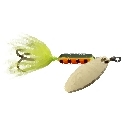Although the design is sophisticated, making an inline spinner is easy, and you can make your own at home. The entire lure is just a wire shaft with an alloy weighted body on it, a treble hook at the tail, a spinner on a clevis in the front, and a loop to tie your line on at the front. Check out the video below for step by step instructions on how to make these great lures.
In 1938, a French Engineer named Andre Meulnart had an idea for a new fishing lure. He took a short length of stiff wire, and threaded a weight on it. He then put on a spinner blade with a rotating clevis that allowed the blade to rotate 360° around the axis of the shaft, and threaded it onto the front of the shaft. He then bent a small loop in each end, one for the line to be attached to, and one to attach a treble hook at the rear. When he tested it at a local body of water, he thought that, in the water, it moved like a butterfly, with the blade spinning rapidly around the shaft as he reeled it in, so he named it the Aglia, the Latin word for butterfly. The lure proved to be extremely productive on most species of fish.

Fast forward to 1956. In Antigo, Wisconsin, a local tackle store owner, Todd Sheldon, was having a rough time on the Wolf River. The fish had all developed “lockjaw” and wouldn’t hit anything. While rummaging through his tackle box for something that might turn the tide, he found one of the little Aglia spinners a GI friend, recently returned from Europe, had given him. After the first cast, his luck changed dramatically, and he caught several large trout in quick succession. He was hooked on the Aglia. So much so that he began to market them from his store. Sales were so good that soon, he sold his store and formed the Mepps Lure company, specializing in the Aglia, and it’s close cousins, the Comet and the Black Fury. The Inline Spinner had been born. Many other companies began copying the design when the patent ran out, but the market continues to be dominated by Mepps, Panther Martin and Worden’s Lures (the Roostertail). Blue Fox is gaining on them, but they still have a ways to go. Mepps is still the #1 lure company in the world, and their best seller is still the Aglia, virtually unchanged for over 70 years. It’s hard to improve on perfection. The only difference is the change from lead to alloy for the weights.
Inline Spinners For Bass Fishing
All inline spinners work the same way, no matter who makes them. The differences are in size, and colors available. But none work any better than the original Aglia. The secret to the lures success is the spinner blade. It does two things. First, it puts out a ton of vibrations in the water, and second, it creates a lot of flash. You can fish them with a straight retrieve, which is the standard way to use them, or use a stop and go method. Some are rigged with a single rear hook, so you can add a trailer to them with plastic grub tails, shad bodies, or even a real minnow. They can be reeled right under the surface, or allowed to sink all the way to the bottom. They are more weedless than you might think, because the spinning blade knocks a lot of stuff out of the way of the hooks.
One particularly effective way to use them for bass fishing requires two rods. Rig one with a live minnow under a bobber. On the other rod, tie on an inline spinner. Cast the minnow out and let it set. Then take the rod with the spinner, cast it out past the bobber, then reel it in rapidly, passing it as close to the minnow as possible. To watching bass, it appears as if a smaller fish is trying to steal their dinner, and no self-respecting bass can ignore that insult.
They’re not often used by most bass anglers so bass are not used to seeing them, this can make them a secret weapon on the water. Pro fisherman Mike Iaconelli keeps a “panic box” on his boat during all tournaments. This box is made up of mostly old fashioned lures that are not commonly fished today. Theres always an inline spinner in there.

